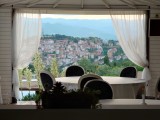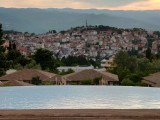Sony Xperia 1 III review

Daylight image quality
Daylight photos from the Xperia 1 III's main camera are really good overall. Detail is on par with other 12MP cameras, but more importantly, it's rendered in a very natural and appealing way - Sony's grass and foliage are some of the best out there. Noise is virtually non-existent in these images.
We're also liking the color rendition - things are looking lively, yet not in an overdone way, and we got consistently accurate white balance as well. Dynamic range is generally excellent though we'd prefer slightly brighter shadows - Sony's contrasty tone curve leaves them a bit too dark for our taste.












Daylight samples, main camera (1x)
The ultrawide camera continues that strong performance, delivering sharp and detailed images on far and near subjects alike. Some softness can be observed towards the extreme corners, but that's not unique to the Xperia, or most lenses, really. Dynamic range is typically respectably wide, though depending on the scene and scene mode the phone goes for, you may end up with the occasional blown highlights like in the snail shot below. Colors maintain that positive impression we got from the main camera and are, in fact, essentially perfectly matched between the two.












Daylight samples, ultrawide camera (0.6x)
Which gets us to the telephoto. The Xperia's images are well detailed at the 2.9x zoom setting (or a 70mm equivalent focal length) but somewhat lacking in bite - absolute sharpness is so-so. That's when the phone manages to acquire focus correctly, which isn't always the case - samples 2 and 6, for example, are out of focus. It's not a prevailing issue, but it does happen more often than we'd like.
We also observed a certain pixelation, particularly notable along diagonal lines (the blue roof 'tiles' of the castle, the snail's tentacles, the 'station' letters) - not a big deal, but unnatural-looking when examining from up close. Some noise is also present in these shots, for a change.
We have little to complain about when it comes colors - they maintain consistency with the other two modules. Dynamic range is very good as well.












Daylight samples, telephoto camera (2.9x, 70mm)
Things get softer at the 4.4x setting. We wouldn't go so far as calling the photos unusable - they're certainly very good at fit-to-screen magnification, and there's fine detail at 1:1 as well, but you need to look for it through a haze that's hard to like.












Daylight samples, telephoto cam (4.4x, 105mm)
Low-light image quality
In low light, the Xperia 1 III's main camera captures sharp and detailed images with well-controlled noise. Color fidelity is maintained as well. Dynamic range is generally good, particularly in the highlight areas, but a boost in shadows and mid-tones wouldn't hurt, especially in darker scenes.
It's typically Night modes on other phones that take care of bringing out shadow detail, but the Xperia 1 III doesn't do Night mode. A classic but flawed argument is that Night modes capture unrealistically bright scenes, and Sony's approach is the more photographically 'correct'. However, human eyes/brains are capable of adjusting for scenes with a very high dynamic range, higher than what a single exposure can capture anyway. Plus, anecdotal data we've gathered over time points that Night mode style processing, unrealistic as it may be, looks more universally pleasing than a more canonical rendition like we have here. That said, there's clearly some multi-exposure image stacking going on on the Xperia, as evidenced by the progress indicator that pops up on the screen when shooting in the dark; it's just that certain scenes would benefit from a more liberal application of it.








Low-light samples, main camera (1x)
The ultrawide camera is pretty well covered by the above assessment as well - sharp, detailed, and low-noise images that could benefit from better-developed shadows.








Low-light samples, ultrawide camera (0.6x)
Switching to the telephoto, the Xperia 1 III's captures decent images at 2.9x. Well-lit scenes are rendered nicely, with good detail and reasonable noise levels. While not pin-sharp, these photos do stand up to scrutiny in the context of 3-ish times zoom camera from competitors in low light. Darker scenes aren't looking quite as good - if they require something more extreme than the apparent ISO 1000 and 1/8s limit, you'd get underexposed photos.








Low-light samples, telephoto camera (2.9x, 70mm)
Sharpness drops significantly at the 4.4x zoom level, and a Mi 11 Ultra's 5x tele will get you notably crispier shots. That said, the Xperia's photos look perfectly okay at fit to screen and exhibit good color and dynamic range. Again, the phone has no answer if the scene is too dark to expose at its maximum ISO 1000 and 1/8s.







Low-light samples, telephoto cam (4.4x, 105mm)
Once you're done with the real-world samples, head over to our Photo compare tool to see how the Sony Xperia 1 III stacks up against the competition.



Sony Xperia 1 III against the Galaxy S21 Ultra and the OnePlus 9 Pro in our Photo compare tool
Portrait mode
The Xperia 1 III bokeh mode can be enabled for the main camera and both zoom levels of the telephoto. Main camera portraits have very good detail on the subject and generally proficient separation of subject from background. No HDR is a bummer, however, particularly for backlit scenes.
The good subject detection remains a feature on the zoom camera's portraits. Here it's aided by the much-improved perspective you get from standing away from your subject. Unfortunately, the telephoto camera simply isn't sharp enough.




Portrait samples (4.4x, 105mm)
Selfies
Sony's lagging behind in its selfie game, and the 8MP front-facing camera is somewhat out of place on a top-tier handset such as the Xperia 1 III - we'd like to see autofocus and some more and/or bigger pixels. That said, it takes okay images with a fairly wide dynamic range and really likable colors. There is adequate detail too, about as much as you could expect from the number on the tin.
Selfie portraits don't get that HDR treatment of the regular photos, and challenging backlit scenes will have their highlights blown out. Subject detection isn't perfect either, with bits of background around clothes lines left sharp and the occasional blurry cheek or ear.
Video recording
The Xperia 1 III records video up to 4K30 with all three of its rear cameras. If you want a higher frame rate, there's the 1080p/60fps option, again on all rear cameras.
Using the Cinema Pro app, you can unlock a host of other frame rates on the main camera - you get 4K at 24, 25, 30, 60, and 120fps, though that's not the full 16:9 UHD type of 4K, but 21:9 3840x1644px instead. The Pro in the name implies a better understanding of video capture parameters and workflow. It requires a certain level of ability (and willingness) to post-process the footage - you likely won't be shooting casual 4K60 clips using the Camera Pro app.
Back to the Basic camera app and its results. Main camera footage in 4K (bit rate is 55Mbps) is overall good. Dynamic range is excellent, and colors are lively yet still mostly accurate. Noise is nearly non-existent too, but it's the level of detail that isn't getting us too excited - virtually all competitors offer an extra bit of crispness and finer textures.
The ultrawide camera maintains the wide dynamic range and dials down the saturation a bit, and footage generally looks great on a global scale. At 1:1 magnification, these videos stand up to scrutiny better and offer competitive levels of detail and sharpness to rivaling high-end smartphones. However, the Mi 11 Ultra in particular still holds a small advantage.
Similarly to stills, the telephoto doesn't quite live up to expectations. While detail isn't strictly bad, there's a prevailing haziness and lack of micro contrast in footage shot at the 2.9x zoom setting. Colors and dynamic range remain hard to fault.
At the 4.4x zoom level, things are looking similarly with a certain lack of definition and local contrast - look at the grass and the road lane markings. Dedicated 5x modules like the ones you'd find on the Mi 11 Ultra and the vivo X60 Pro+, for example, are vastly superior.
Stabilization on the main camera is very good, and the phone will competently iron out the walking shake. Pans have smooth transitions, too.
The ultrawide camera continues with the strong performance and also delivers very stable footage.
The output from the telephoto camera isn't quite as steady, whether it's at 2.9x or 4.4x zoom. Even though it does offer a significant improvement over the non-stabilized mode, there is a noticeable shake remaining in the resulting footage with stabilization enabled.
Here's a glimpse of how the Sony Xperia 1 III compares to rivals in our Video compare tool. Head over there for the complete picture.



Sony Xperia 1 III against the Galaxy S21 Ultra and the OnePlus 9 Pro in our Video compare tool
Reader comments
- Ttttttt
- 10 Mar 2025
- XW4
Front camera of xsmax is sharper and hold better quality tha xpera 1 mark 3 back cameras
- A
- 10 Aug 2024
- TqP
If you want a goof song fhone, you should buy a 1/5 III or IV. If you buy one used, you can get it for like 300-500 €.
- Ali
- 06 May 2024
- uRB
I bought Sony Xperia 1III a month ago .I love it .I bought specially for gaming(pubg). It's Soo smooth.jst charging process is slow















